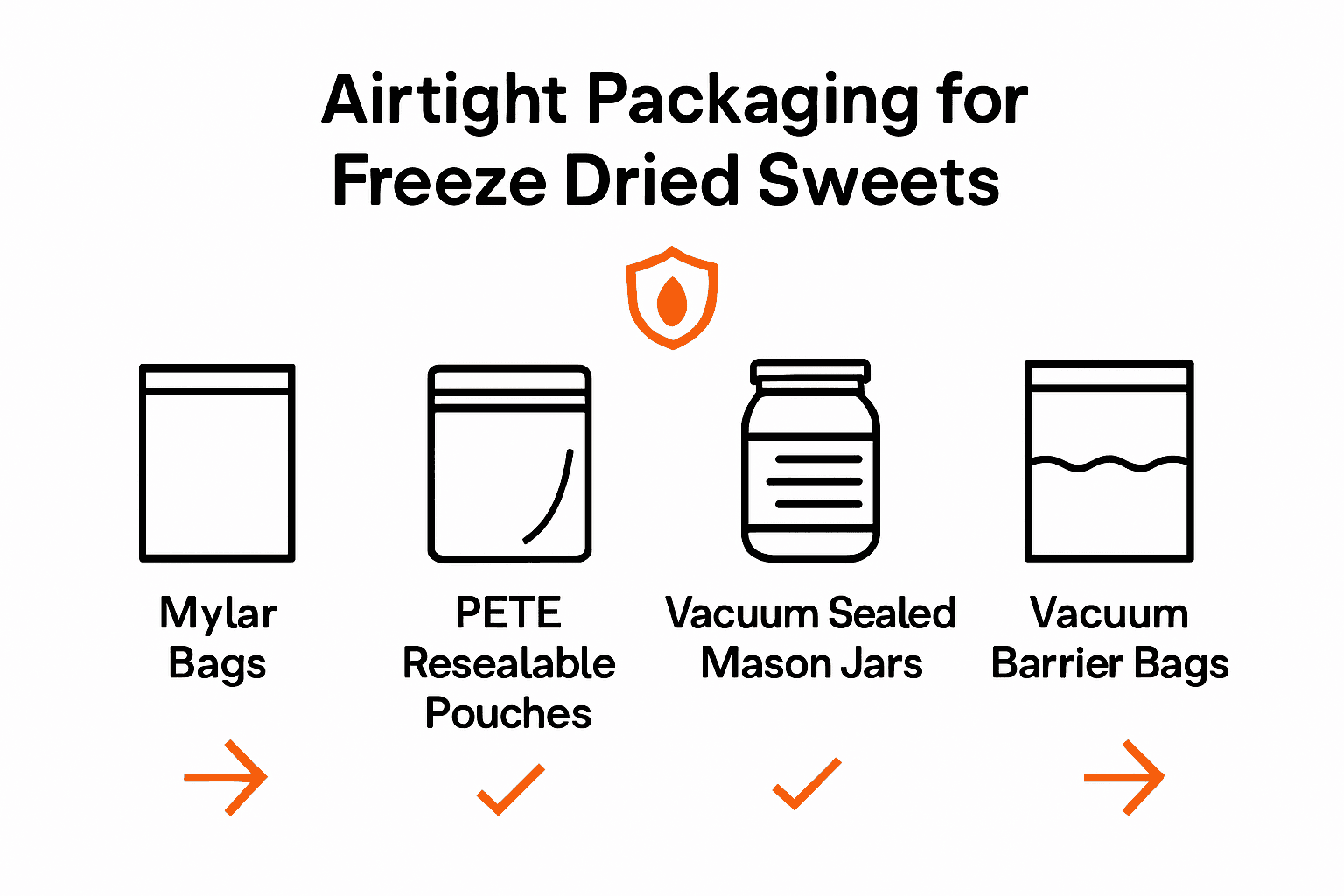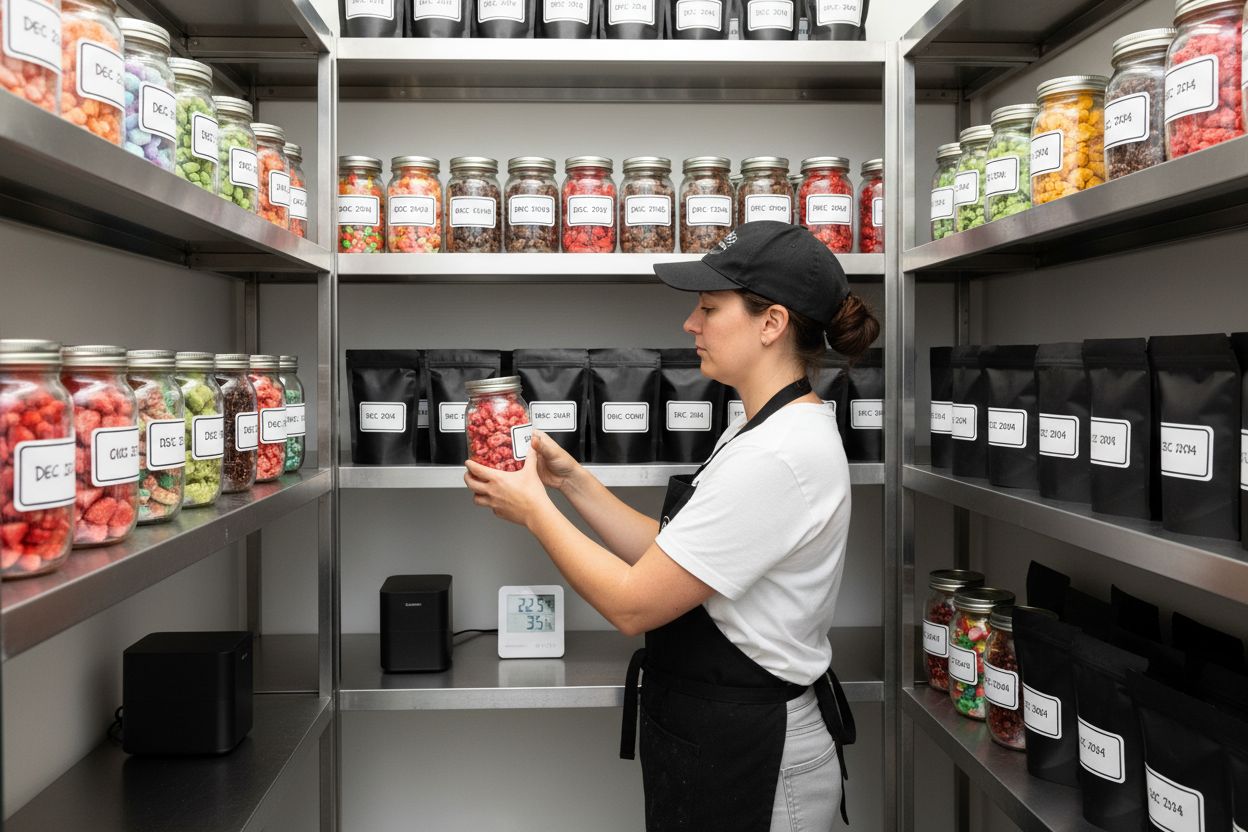Did you know that improper storage can cause freeze dried sweets to lose up to 80 percent of their crispness in just a few days? These treats are a favorite for their unique texture and long shelf life, yet many people unknowingly let moisture or heat ruin their stash. With the right methods, you can keep every bite fresh and flavorful much longer, enjoying your sweets with perfect crunch every time.
Quick Summary
| Key Point | Explanation |
|---|---|
| 1. Choose airtight packaging carefully | Select containers like Mylar bags or vacuum sealed jars to prevent moisture and oxygen from spoiling your sweets. |
| 2. Maintain ideal storage conditions | Keep temperatures below 75°F and humidity below 60% to preserve the quality and shelf life of freeze dried treats. |
| 3. Implement a labeling system | Clearly label containers with food names and dates to track inventory and ensure older stock is used first. |
| 4. Conduct regular quality inspections | Regularly check for off odors, discoloration, or leaks in packaging, discarding any compromised items immediately. |
| 5. Rotate stock using FIFO method | Follow the First-In-First-Out strategy to manage inventory effectively and reduce waste by using older products first. |
Table of Contents
- Step 1: Select Proper Airtight Packaging For Storage
- Step 2: Control Temperature And Humidity In Storage Area
- Step 3: Label And Organize Inventory By Date And Flavor
- Step 4: Inspect Stored Sweets For Quality Assurance
- Step 5: Rotate Stock To Maintain Optimal Freshness
Step 1: Select proper airtight packaging for storage
Choosing the right packaging for your freeze dried sweets is critical to maintaining their crispness and flavor. Your goal here is to create an impenetrable barrier against moisture and oxygen that could compromise your delicious treats.
Start by selecting containers specifically designed for long term food storage. According to research from food preservation experts, freeze dried foods absorb moisture incredibly fast. You want containers that are hermetically sealed and provide superior moisture protection. Some top options include Mylar bags, PETE resealable pouches, and vacuum sealed moisture barrier bags.
Vacuum sealed mason jars are another excellent choice. These robust containers create an airtight environment that locks out humidity and potential contaminants. Pro tip: pair your container with food grade desiccant packets and oxygen absorbers. These little heroes work behind the scenes to extract any remaining moisture and oxygen that might sneak into your packaging.
Quick warning: Not all plastic containers are created equal. Always choose food grade materials that are specifically rated for long term storage.
When selecting your packaging, look for options with robust sealing mechanisms. Zip lock style closures or heat sealable bags work wonderfully. The key is creating a tight seal that prevents any external air or moisture from entering.
Here’s a comparison of popular airtight packaging options for freeze dried sweets:

| Packaging Type | Key Benefits | Considerations |
|---|---|---|
| Mylar Bags | Superior moisture barrier Lightweight |
Requires heat sealing Not reusable |
| PETE Resealable Pouches | Resealable closure Clear for viewing |
Less robust than Mylar May need extra moisture protection |
| Vacuum Sealed Mason Jars | Reusable Strong airtight seal |
Breakable Heavier & bulkier |
| Vacuum Barrier Bags | Maximum air removal Good for bulk storage |
Requires vacuum sealer Single use |
Check out our guide on understanding custom packaging for more insights into selecting the perfect storage solution for your freeze dried sweets.
By investing a little time in selecting the right packaging, you will ensure your freeze dried treats stay crisp, flavorful, and ready to enjoy whenever the craving strikes.
Step 2: Control temperature and humidity in storage area
Now that you have selected the perfect packaging for your freeze dried sweets, the next critical step is creating an optimal storage environment. Your primary mission is to maintain consistent temperature and humidity levels that preserve the quality and extend the shelf life of your treats.
According to food preservation research, the ideal storage temperature for dried products ranges between 32°F and 70°F (0–21°C). As experts from the agriculture institute highlight, temperature fluctuations can accelerate spoilage and cause unwanted condensation. Aim for a stable environment that keeps your freeze dried sweets in peak condition.
Specifically for freeze dried foods, maintaining temperatures below 75°F (24°C) is crucial. While cool temperatures are acceptable, excessive heat can dramatically shorten the longevity of your products. Even items with a 30-year guarantee can lose their quality if exposed to higher temperatures.
Pro tip: Consider using a dedicated storage area like a pantry or cabinet away from direct sunlight and heat sources.
Humidity control is equally important. Keep relative humidity below 60% to prevent moisture absorption. Tools like dehumidifiers or desiccant packets can help manage moisture levels. If you live in a particularly humid climate, investing in a small dehumidifier for your storage space might be a smart move.
Check out our guide on understanding custom packaging to complement your storage strategy and ensure maximum freshness.
By carefully controlling temperature and humidity, you will safeguard the crisp texture and delightful flavor of your freeze dried sweets for months or even years to come.

Step 3: Label and organize inventory by date and flavor
Effective inventory management is the secret sauce to keeping your freeze dried sweets in tip top shape. Your mission is to create a labeling and organizational system that helps you track every delicious batch with precision and ease.
Every container deserves a clear label that tells its complete story. According to food preservation experts, each package should display the food name and the processing date. Take this a step further by considering innovative tracking methods like QR codes that can link to detailed batch information including ingredient lists, potential allergens, and even rehydration instructions.
Implement a simple yet effective stock rotation strategy. Store newer batches behind older ones to ensure you are always using the oldest stock first. This first in first out approach prevents any treats from sitting forgotten in the back of your storage area. You can track this using a simple inventory spreadsheet or by organizing your crates in a chronological manner.
Pro tip: Consider using waterproof labels or permanent markers that won’t fade or smudge over time.
For long term storage, take inspiration from professional food manufacturers. Some companies recommend writing the manufacturing date and a 25-year best by date directly on the container. This makes tracking your inventory longevity incredibly straightforward.
Learn more about the fascinating world of freeze dried treats in our comprehensive guide to freeze dried candy.
By investing a little time in careful organization, you will transform your storage area into an efficiently managed sweet sanctuary that preserves your treats in perfect condition.
Step 4: Inspect stored sweets for quality assurance
Regular quality checks are your first line of defense in maintaining the delectable perfection of your freeze dried sweets. Think of this step as a routine health checkup for your tasty treasures.
According to food safety research, dry foods stored under improper conditions can deteriorate quickly. Your inspection should focus on multiple sensory and visual indicators. Look for any signs of trouble like off odors, unusual flavors, unexpected discoloration, or texture changes that might suggest compromised quality.
Start by examining the packaging itself. Research from agricultural extension services emphasizes that packaging integrity is crucial. Check for any signs of rust, swelling, or potential leaks. These could be red flags indicating moisture infiltration or potential contamination. Any containers showing these warning signs should be immediately removed and discarded to prevent potential spoilage.
Warning: Trust your senses. If something looks or smells suspicious, it probably is.
Moisture and temperature monitoring are critical. High humidity environments can trigger mold growth, bacterial proliferation, and packaging degradation. During your inspection, pay attention to the surrounding storage conditions. Feel the containers and packaging for any unusual dampness or condensation.
Learn more about the science behind food preservation in our comprehensive guide to freeze dried candy.
By conducting these thorough and regular quality checks, you will ensure that every sweet remains as delicious and crisp as the day it was packaged. Consistency is key in preserving your freeze dried delights.
Step 5: Rotate stock to maintain optimal freshness
Rotating your freeze dried sweets stock is like playing a strategic game of flavor preservation. Your goal is to ensure every sweet gets its moment in the spotlight before reaching its peak quality point.
According to stock management experts, the First-In-First-Out (FIFO) practice is your secret weapon. This method means placing earlier dated items in the front of your storage area so they are used first. Newer items get tucked behind, creating a natural flow that minimizes waste and guarantees you are always consuming your oldest stock at its prime.
Documenting your rotation process is crucial. Professional food management systems recommend clearly labeling each item with its receival or production date. This simple step transforms your storage area from a chaotic candy collection into a well organized preservation system. By tracking these dates, you create a transparent trail that helps you manage inventory with precision.
Pro tip: Use a permanent marker or waterproof labels to mark dates directly on packaging to prevent smudging or fading.
Creating a consistent rotation routine takes practice. Set aside a few minutes each month to reorganize your stock. Move older packages to the front and newer ones to the back. This small investment of time prevents forgotten packages from lingering past their optimal consumption window.
Learn more about preserving your favorite treats in our comprehensive guide to storing freeze dried foods.
By mastering stock rotation, you will transform your freeze dried sweet storage from random stacking to a strategic system that guarantees maximum flavor and quality.
Ready to Protect Your Freeze Dried Sweets? Let the Experts Help
You have learned how airtight packaging, proper storage conditions, and careful stock rotation make all the difference in keeping your freeze dried sweets crisp and irresistible. The biggest challenge is often finding packaging solutions that truly lock out moisture and oxygen while supporting your long term freshness goals.
If you want confidence that your treats will stay fresh, let our team at Space-Man.ca help. We are not just Canada’s leading freeze dried candy manufacturer and distributor. We also specialize in custom packaging, private labeling, and co-packing services designed for brands and sweet entrepreneurs who want to step up their preservation game. Whether you need bulk bagging, small batch packaging, or labeling that keeps inventory organized for months, we can deliver exactly what your article recommends.

Don’t let humidity or improper storage ruin your hard work. Take the next step and discover our freeze dried candy solutions. Or dive deeper into proper storage with our complete guide on storing freeze dried foods. Contact us or browse our online store today for packaging that is engineered for ultimate freshness. Your sweets deserve the best storage and so do your customers.
Frequently Asked Questions
How should I package freeze dried sweets for maximum freshness?
To ensure maximum freshness, use airtight packaging like Mylar bags or vacuum sealed mason jars. Always include food grade desiccant packets to absorb any remaining moisture in the packaging.
What temperature and humidity levels should I maintain for storing freeze dried sweets?
Store freeze dried sweets in a cool environment ideally between 32°F and 70°F (0–21°C) with humidity levels below 60%. Regularly check and adjust conditions to prevent moisture absorption that can compromise freshness.
How can I label my containers to track freshness effectively?
Label each container with the food name and processing date to keep track of freshness. Consider using waterproof labels or permanent markers to ensure the information remains legible over time.
How often should I inspect my stored freeze dried sweets?
Inspect your stored sweets at least once a month for signs of spoilage, such as off odors or packaging integrity issues. Regular checks help maintain quality, ensuring your treats remain delicious and safe to eat.
What is the best way to rotate my stock of freeze dried sweets?
Implement a First-In-First-Out (FIFO) strategy by placing older items at the front of your storage area and newer items behind them. Setting a routine to reorganize your stock monthly can help prevent any items from exceeding their optimal consumption window.
Can I reuse packaging for freeze dried sweets?
Avoid reusing packaging unless it is specifically designed for long-term food storage and has been cleaned thoroughly. Properly seal new batches in fresh, airtight containers to maintain the highest quality and freshness.

